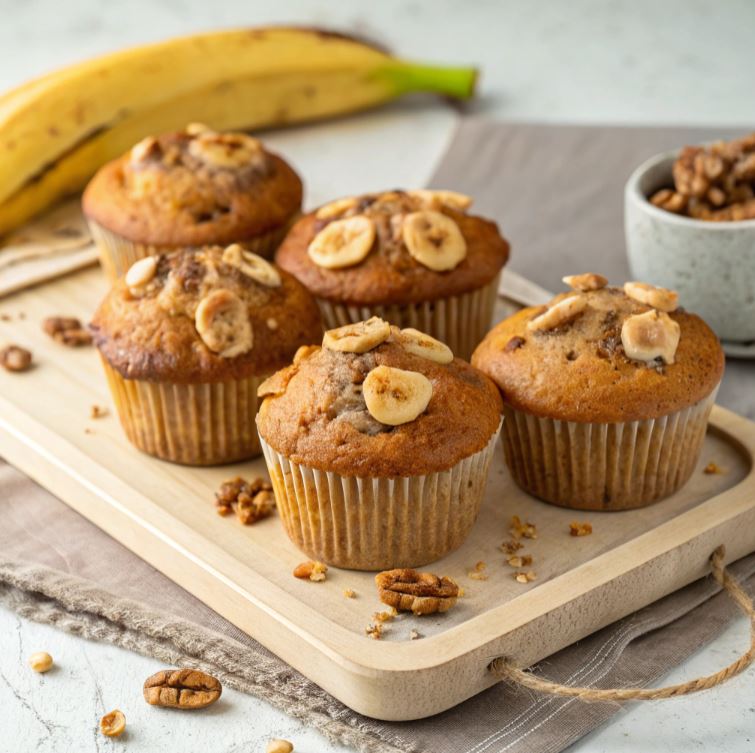Gluten free banana nut bread muffins are a fantastic option for those looking to enjoy a moist, flavorful treat without gluten. Whether you have celiac disease, gluten intolerance, or simply prefer to reduce gluten in your diet, these muffins provide a nutritious and satisfying snack. Made with ripe bananas, crunchy nuts, and gluten-free flour, they offer a delightful texture and taste.

These muffins are not just for those avoiding gluten; they are loved by anyone who appreciates a naturally sweet and nutty baked good. The combination of bananas and nuts creates a harmonious balance of flavors, making them perfect for breakfast, snacks, or dessert. Additionally, they are easy to make and can be customized with various add-ins like chocolate chips or seeds for extra texture and flavor.
History and Origins of Gluten Free Banana Nut Bread Muffins
The origins of gluten free banana nut bread muffins can be traced back to traditional banana bread recipes, which became popular in the United States in the early 20th century. When baking powder and baking soda became household staples, banana bread recipes flourished, allowing home bakers to create light and fluffy loaves without yeast.
As gluten-free diets gained popularity due to increasing awareness of gluten intolerance and celiac disease, bakers began experimenting with alternative flours such as almond, coconut, and oat flour. This led to the adaptation of traditional banana nut bread into a gluten free banana nut bread muffins recipe, maintaining the essence of the classic while making it accessible to those avoiding gluten.
Gluten Free Banana Nut Bread Muffins All Over the World
The love for gluten free banana nut bread muffins has spread globally, with different cultures adding their own unique twists. In North America, they are often enhanced with pecans or walnuts and occasionally include chocolate chips for added sweetness.
In European countries, bakers sometimes incorporate hazelnuts or almonds, complementing the nutty profile of the muffins. Meanwhile, in Asian countries, variations include ingredients like coconut, sesame seeds, or even matcha powder to create a unique blend of flavors.
No matter where they are made, these muffins remain a beloved snack, combining the wholesome goodness of bananas with the satisfying crunch of nuts. The global appeal of gluten free banana nut bread muffins highlights their versatility and ability to cater to a wide range of dietary needs and taste preferences.
Detailed Ingredients for Gluten Free Banana Nut Bread Muffins
To make the best gluten free banana nut bread muffins, it’s important to use high-quality, fresh ingredients. Below is a breakdown of what you’ll need:
Core Ingredients:

- Ripe bananas (3 medium-sized): The riper the bananas, the sweeter and more flavorful the muffins.
- Gluten-free flour blend (2 cups): A mix of almond, oat, or coconut flour works well.
- Eggs (2 large): Helps bind the ingredients and create structure.
- Chopped nuts (½ cup): Walnuts or pecans add texture and depth.
- Brown sugar (½ cup): Enhances sweetness while keeping the muffins moist.
- Unsweetened applesauce (¼ cup): A healthier alternative to oil, keeping the muffins soft.
- Baking soda (1 teaspoon): Ensures a light, fluffy texture.
- Cinnamon (1 teaspoon): Adds warmth and enhances the banana flavor.
- Salt (¼ teaspoon): Balances the sweetness.
- Vanilla extract (1 teaspoon): Elevates the overall flavor profile.
- Melted coconut oil or butter (¼ cup): Provides richness and moisture.
Step-by-Step Instructions
Making this muffins recipe is a straightforward process. Follow these steps for perfectly baked muffins:
- Preheat the oven to 350°F (175°C). Line a muffin tin with paper liners or lightly grease it.
- Mash the bananas in a large bowl until smooth. Using overripe bananas ensures natural sweetness.
- Add the wet ingredients (eggs, applesauce, melted coconut oil, and vanilla extract) and mix until well combined.
- In a separate bowl, whisk together the dry ingredients (gluten-free flour, baking soda, cinnamon, and salt).
- Slowly incorporate the dry ingredients into the wet mixture, stirring gently until just combined. Overmixing can result in dense muffins.
- Fold in the chopped nuts carefully, ensuring even distribution throughout the batter.
- Divide the batter evenly among the muffin cups, filling each about ¾ full.
- Bake for 18-22 minutes or until a toothpick inserted in the center comes out clean.
- Let them cool in the pan for 5 minutes before transferring to a wire rack.
Tips for Perfect Gluten Free Banana Nut Bread Muffins
For the best results, keep these key tips in mind:
- Use room temperature eggs to ensure even mixing.
- Measure the flour properly by spooning it into the measuring cup and leveling it off.
- Let the batter rest for 10 minutes before baking to improve texture.
- Add extra moisture if needed by incorporating a tablespoon of yogurt or milk.
- Store muffins properly in an airtight container at room temperature for up to three days or freeze for longer storage.
Health Benefits of Gluten Free Banana Nut Bread Muffins
Eating gluten free banana nut bread muffins provides a variety of health benefits:
- Rich in potassium: Bananas support heart health and help regulate blood pressure.
- Good source of fiber: Aids digestion and promotes gut health.
- Naturally gluten-free: Ideal for individuals with gluten intolerance or celiac disease.
- Contains healthy fats: Nuts provide beneficial omega-3 fatty acids.
- Low in refined sugar: Using natural sweeteners reduces the overall sugar content.
Diet Information
Understanding the nutritional content of this recipe is essential for making informed dietary choices. Below is a general breakdown per muffin:
- Calories: Approximately 180-220 kcal
- Carbohydrates: 28g (mostly from bananas and gluten-free flour)
- Protein: 4g (from eggs and nuts)
- Fat: 8-10g (healthy fats from nuts and coconut oil)
- Fiber: 3g (supports digestion)
- Sugar: 10g (natural sugars from bananas and a small amount of added sweetener)
For those following specific diets, these muffins can be modified:
- Keto-friendly: Substitute gluten-free flour with almond flour and use a sugar substitute.
- Vegan: Replace eggs with flax eggs and use plant-based milk.
- Low-sugar: Reduce sugar by increasing cinnamon and vanilla for natural sweetness
